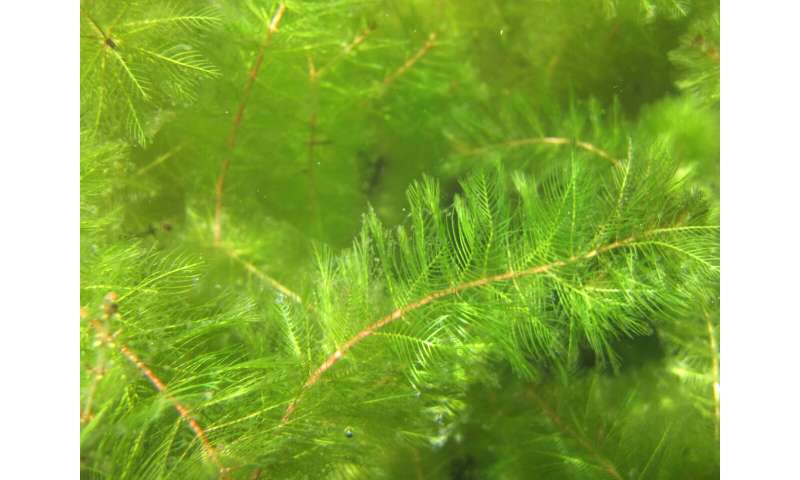#Controlling invasive milfoil with lake-wide herbicide could do more harm than good to native plants
“#Controlling invasive milfoil with lake-wide herbicide could do more harm than good to native plants”

Invasive Eurasian water milfoil is flourishing in Wisconsin’s lakes, sometimes outcompeting native plants and creating floating mats that cause problems for people, boats and property values. But new research shows that the benefits of using one type of historical lake-wide herbicide treatment may be outweighed by the costs to native aquatic plants.
Scientists from the Wisconsin Department of Natural Resources and University of Wisconsin–Madison analyzed more than 600 surveys of plant life conducted in 442 Wisconsin lakes by the DNR, local lake associations and private companies. They focused on how native plant species fared when in the presence of milfoil, versus when exposed to lake-wide herbicide treatments.
Lake management teams often try to tackle their milfoil problems with chemicals, which reduce the size of the milfoil population but can have off-target effects. In most lakes, lake-wide herbicide treatments are associated with more native plant declines than the milfoil, according to the study, published recently in the journal Facets.
But not every lake responds to herbicides or milfoil invasions in the same way, and each lake has a variety of different stakeholders involved to take into consideration, according to Alison Mikulyuk, a DNR aquatic scientist who co-authored the study with DNR colleagues and UW–Madison limnologist Jake Vander Zanden, whose lab Mikulyuk worked in while earning her doctorate.
For many lakes, Mikulyuk says, it’s likely they may not have to use a lake-wide herbicide treatment on milfoil until native plant species are clearly suffering. For other lakes, a control regime not involving herbicides may work instead.
“A lake-wide approach to managing Eurasian water milfoil is not a one-size-fits-all kind of thing,” Mikulyuk says. “Lake-wide treatments like this may be only appropriate for situations where adverse Eurasian water milfoil effects are very clear.”
The researchers recommend lake managers craft a plan based on integrated pest management (IPM), a philosophy designed to aid in decision-making about herbicides versus alternative methods when controlling invasive species or pests. An integrated pest management strategy could help managers choose between using lighter herbicide treatments with increased mechanical control—for example, hand-picking milfoil—or only using herbicides when the milfoil becomes too widespread.
“The answer isn’t always ‘yes’ and it isn’t always ‘no.’ Each system that milfoil invades is unique, it’s a unique event,” Mikulyuk says. “And in general, it’s not a death sentence for a lake if an invasive species is introduced. But in some cases they can be really problematic. In some cases they really can have negative ecological impacts on the community itself.”
Vander Zanden says Mikulyuk’s work over the years has brought a new dimension to his lab, which typically studies fish and aquatic invertebrates, and—through her connections at the DNR—amplified Vander Zanden’s focus on finding opportunities to apply UW–Madison research.
“When she started her PhD in my lab, she was already a scientist at the DNR, and an expert on aquatic plants and the management of invasive water milfoil,” Vander Zanden says, “so from the start there was a mutual exchange of ideas. She also brought insights into my lab group that derived from her experience working for our state’s natural resource management agency. As a result, much of the work in my lab group emphasizes the ‘So what?’ question.”
As for the “So what?” with herbicide control of milfoil, Mikulyuk hopes her research will help lake managers make cautious, more informed decisions about their invasive species control strategies. Now, she and the DNR are working on an online portal to help disseminate their water milfoil data easily.
“(Our data) has been used for globally significant macro-site biodiversity questions already,” Mikulyuk says. “And I hope that with the integration of this new application and our movement towards data centralization that this data will be easier and easier to use.”
Citation:
Controlling invasive milfoil with lake-wide herbicide could do more harm than good to native plants (2020, June 12)
retrieved 12 June 2020
from https://phys.org/news/2020-06-invasive-milfoil-lake-wide-herbicide-good.html
This document is subject to copyright. Apart from any fair dealing for the purpose of private study or research, no
part may be reproduced without the written permission. The content is provided for information purposes only.
If you want to read more Like this articles, you can visit our Science category.
if you want to watch Movies or Tv Shows go to Dizi.BuradaBiliyorum.Com for forums sites go to Forum.BuradaBiliyorum.Com



